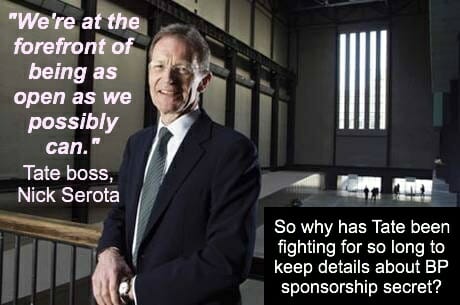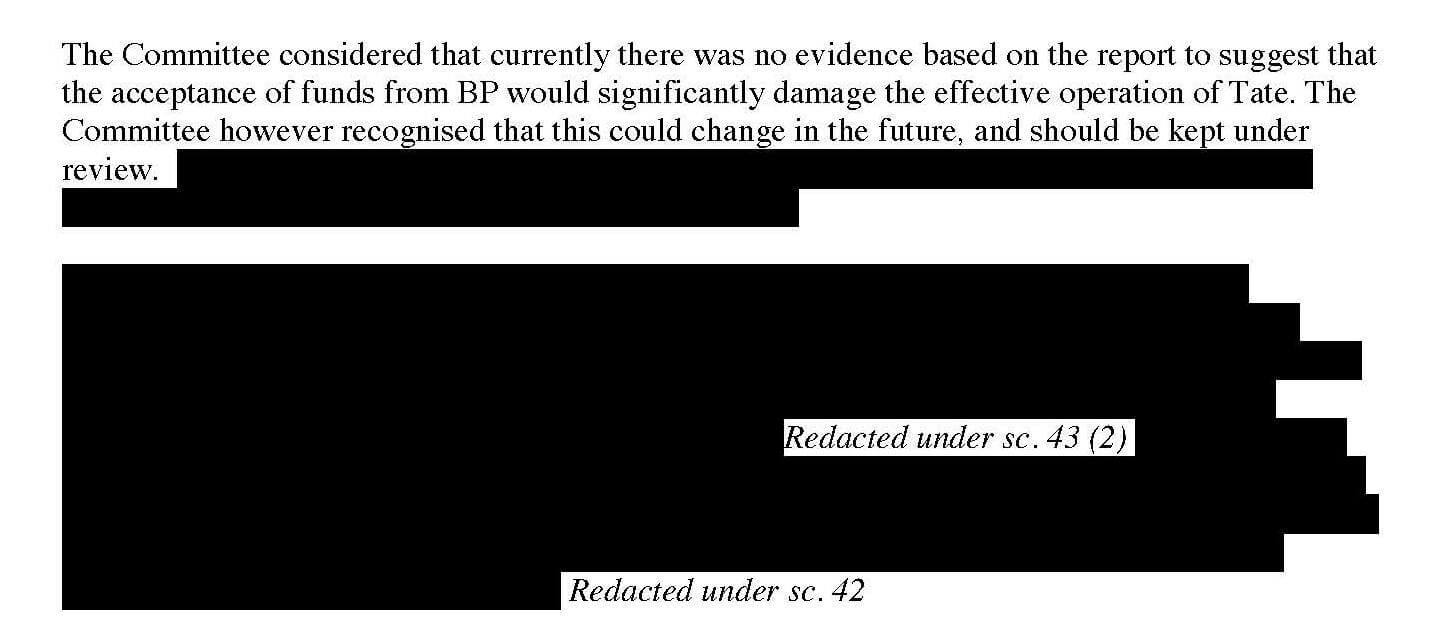 We’re a more open organisation than any equivalent organisation in the world…
We’re a more open organisation than any equivalent organisation in the world…
—-So said Nick Serota back in 2008.
More open than the National Gallery, for instance, who took three weeks to reveal its £30,000 /year sponsorship deal with Finmeccanica to Campaign Against the Arms Trade? Or how about the Natural History Museum, who took a month to reveal that they received £750,000 over two years from Shell.
It’s now been more than two years since Glen Tarman first asked Tate how much they could be bought for. So much for Serota’s bragging.
But this legal battle, though dry in parts, brings up some interesting questions
Just how much (or little)?
Tate’s pushback, far from putting us off, is only whetting our appetites for the end result. According to the Tate, releasing this information would cause such public protest that it would be likely to endanger the health and safety of the public. Perhaps Liberate Tate should be invited to comment. What sum of money would lead protests to take a more violent angle? Happily, the Information Commissioner (IC) did not see Liberate Tate et al’s performances as so inherently threatening, and quickly shut down these arguments.
But the Information Commissioner is in agreement with Tate that release of the sums that BP has given to the gallery over the last two decades would prejudice Tate’s commercial interests. We have been told next to nothing on why they think this is engaged: the IC’s discussions with the Tate lawyers take place in the closed space of the closed decision notice. We, on the outside, can only speculate. What we do know is that in order for this exemption to be engaged they have to prove a causal link between releasing information on sponsorship from 20 years ago would prejudice these interests
Who calls the shots?
After two years of heels being dug in and lord knows how much in lawyers’ fees, we are puzzled on the commercial interests point. Surely Tate’s commercial interests lie in giving up the ghost and revealing all. Which then begs the question of whether it’s Tate pulling the strings here or BP? Of course these can lines become blurred when you’ve got their former CEO in a position of power….
Lord Browne of Madingley: judge, jury and executioner?
In the secret warrens of UK government, Browne is always scurrying around. One minute he’s a Cabinet lead, the next, an external lobbyist for his new shenanigans, Cuadrilla. It can get a little dizzymaking. But this is the first of our cases when he has been the decision maker.
When deciding whether releasing information about BP sponsorship would inhibit “free and frank discussion”, Tate had to pick a “qualified person” to take the call. And who better placed than BP’s former CEO, the man who had led the company through most of its relationship with Tate, and who now also happens to be Chair of the Board of Trustees at the Tate [funny old world].
Although the Information Commissioner agreed on the use of the “free and frank” discussion argument, she decided that this was outweighed by the “public interest” and ordered Tate to reveal the redactions.
It’s great to see “the weight of public interest” in this case being legally acknowledged. Tate would like to make out that this is a very marginal issue, and would discount the numerous petitions and performances that have taken place in recent years, alongside the many interventions made by artists, gallery goers and Tate Members.
Tate tacitly frames the support from BP as a necessity, but an informed public debate on the issue of oil money in the arts depends on their being transparency as to the amounts of money involved, and the criteria that Tate uses in maintaining the controversial arrangement. We’re getting closer to this point as Tate runs out of legal recourses to block disclosure.
This guest blog was written by Margot Gibbs of Request Initiative.
